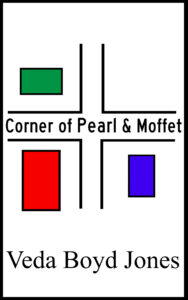When I think of peace, I am transported to Aunt Punch’s farm. One day when I was around ten, we sat under a huge walnut tree in her front yard in metal lawn chairs. You know how there are moments in your life when you can remember a feeling? That was one of those moments. A feeling of contentment washed over me at a time when I probably couldn’t have named it.
It was the same when I visited in my early 20s. We sat in those same metal chairs. Punch was always upbeat, even though she had reasons not to be. Her motto was “This, too, shall pass” when confronted with troubles. Maybe that’s why I felt so at peace there surrounded by nature’s sounds—birds chirping, cows mooing, and the occasional bullfrog singing a deep bass love song down at the creek.
There was plenty I wanted to talk about with her, but some things I didn’t bring up. One day at Grandma’s when I was in my teens, I overheard my aunts talking about WWII. One mentioned Punch’s husband being killed. Punch said they were only engaged, and she didn’t know why he claimed otherwise and left his army life insurance to her. She had given it to his parents.
When she was 26, Punch married a widower who was 67. They were married until his death 15 years later. To their union was born Neal, who died on his way to living. The cord wrapped around his neck in the birth canal, strangling him. Of course, it was a home birth back then. If that were now, he would have been saved. Their next son was my age, and he became an alcoholic and died of liver failure in his late 40s. He was in a horrific semi/car accident on the day he enrolled at junior college. He lived with back pain, although he eventually owned and ran a liquor store/gas station where his relief/poison was always available. After his death, Punch told me he was her “biggest joy and biggest sorrow.”
When I was in first grade, Punch’s house burned down in the night. The best anyone figured, a mouse chewed through an electric wire. I remember being out there the next morning and seeing smoke still rising from the ruins. Nothing left. An old school house was conveyed to the site and became their home. Six years later they added an indoor bathroom.
Aunt Punch was Mom’s older sister. She wore Big Smith overalls since her chores as a kid were outside, milking, putting up hay, tending the garden, while her sisters worked in the house, cleaning and cooking. Once when I was visiting, long after she became a widow at 41, she told me how she was teased when she wore a dress. “Didn’t know you, Punch,” some would say. I told her she ought to look at pants suits that were fashionable then. She bought several and wore them to community suppers at the Legion hut and music parties where she played guitar.
Mom inherited Punch’s antique secretary, and much later, I inherited it from Mom. Imagine my surprise when I started through one drawer and found a framed photo of Punch’s fiancé. With it was the telegram from the war department informing her that he was missing in action over Italy.
As I was just writing about her fiancé, I took a break and went downstairs to look at that telegram again. The small box it’s in is full of old letters, and I dug deeper than I have before and found love letters from her fiancé. “Dearest darling,” one started. I read it and decided this was Aunt Punch’s privacy I was invading all these years later, and I quickly put everything back in the box.
I have always wanted to write a historical novel about Aunt Punch, to give her the life I wish she’d had without so many heartaches. But once I invented a town and the main character and decided to stop time at 1954, I had to create obstacles to overcome. Fiction needs a heroine rising above problems and triumphing. Aunt Punch is not my fictional Josie Jameson in Corner of Pearl & Moffet, but I’ve borrowed some of her characteristics…including those Big Smith overalls.
Corner of Pearl & Moffet is available on the Kindle app on your phone or tablet.
Travel back to small town life in 1954 to meet the people who live on the Corner of Pearl & Moffet.
Before 33-year-old Josie Jameson takes the seat reserved for the widow, she glances around the old graveyard. Close to four hundred people have gathered to pay their respects to her late husband. That is nearly the population of Ducane, Arkansas.
She had married Orville nine years earlier. That he was 43 years her senior hadn’t really troubled her, but there had been plenty of talk. She was a farm girl when she married and moved to the big white house on the corner of Pearl and Moffet. She didn’t fit the mold of housewife to the richest man in town. Now that he’s dead, she owns the Ducane Savings and Loan, The Station that makes more money from liquor sales than gasoline, his private ledger books with unofficial loans and repayment schedules, and the little brown books written in his tight scrawl that hold the town’s secrets.
When tragedy strikes, the good people of Ducane, who share each other’s joys and sorrows, who celebrate others’ accomplishments with pride, who take food to the bereaved and do chores for those who are sick, these same good people whisper behind their hands, “This is Josie’s fault!”
Corner of Pearl & Moffet is a gripping tale of one woman’s struggle through sorrow and challenges to find her own life. Download your copy today.

